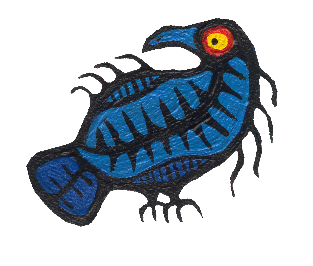Native-Art-in-Canada has affiliate relationships with some businesses and may receive a commission if readers choose to make a purchase.
- Home
- Traditional Knowledge
Traditional Knowledge
Traditional knowledge when internalized by the Anishnabe reveals the ideal Path of Life. The knowledge when it is put into use over a lifetime allows one to be Anishnabe - a good being. It is a process that lasts a lifetime.
The chinshinabe are the traditional teachers who are the caretakers of Ojibwa culture and sacred knowledge. They are insistent that the sacred oral teachings must not be shared in the written form because of the dynamic nature of the relationship between the teacher and the taught, between the human and the non-human 'beings' in the universe and the sanctified nature of the connection between Gze Manidoo and all of Creation.
I agree.
The traditional knowlege should be continued in the oral tradition so what you have here is simply a distilled outline of the philosophy of a nation.
- Learning from Listening - The Anishnabe refer to this as Bzindamowin which is a way of learning that comes from listening to cultural stories.
- Traditional Knowledge - The Anishnabe call thiskendaaswin. It refers to knowlege that is passed down from one generation to the next through ceremonial teachings.
- Knowledge from Observation - The Anishnabe call this Gnawaaminjigewin. It refers to knowlege that is absorbed from looking, seeing and witnessing.
- Earth Based Knowledge - The Anishbabe call this Eshkakimikwe-Kendaaswin and it refers to the knowledge that is associated with Mother Earth.
- Original Instructions given by Gzhe- manidoo - The Anishnabe refer to this as kiiniihgona manda Kendaaswin.
- Spirit Memory - the Anishnabeg refer to this as manidoo-minjimendamowin.
Because the stories are so old there is almost no human experience which hasn't been given in-depth consideration and so within them are implicit lessons and directions for being Anishnabe, a good being.
For the Anishnabeg the telling of a cultural story has two aspects.
In the first instance there is the story teller who is in a position to create a relationship with the listener.
The two are engaged visually, orally and intellectually and the audience has the opportunity to pay attention to the underlying meaning of the spoken words.
Sometimes when the story is told by a different speaker it comes out with a slightly different focus because the new story teller brings a different life experience to the tale. In the same way, when a different audience 'hears' the story from another point of view there can be another slight shift in meaning.
So the cultural stories are not just rote repetition of words. They are a constantly changing recombination of the elements that eventually consider all probable and possible combinations of life's activities and concerns.
The other side of the cultural story is found in the Anishnabe word for ' cultural story' - aadizookaan.
For the Ojibwa, aadizookaan is a living (but not human) being who is the spirit of the story, a being who has existed from time immemorial and has always been available for social interaction with the Anishnabeg. Aadizookaan has observed man's success and failures throughout time and has the ability to share that knowledge with the good beings.
The aadizookaan speaks through the voice of the cultural story teller who has the ability to shape the story to make it appropriate to the time and the situation. Nevertheless the message that is shared remains constant through time.
The Anishnabeg understand that the aadizookaan tells them a story that actually happened in the past...but that could be the human past or the past of non human brings. That doesn't mean that there were two pasts but rather different dimensions of the same past.
In some cases aadizookaan can communicate directly with an individual through a dream path. In the dream the spoken word is replaced by implicit meaning of the thought.
Kendaaswin is sourced directly from Gzhe-Manidoo and concerns all aspects of Creation. The Anishnabeg are inherently
The process of performing the traditional ceremonies allow the voice of the Great Spirit to be heard. Traditional knowledge teaches respect for all life and nurtures the relationship that exists between all living beings.
Ceremonial teachings give structure to proper behavior in the day to day world.
There is a ceremony for a child's first hunt, for example. The Elder's and traditional teachers share their knowledge of behaviour that is appropriate to taking a life. It involves the proper ceremonial processes to ready oneself for the hunt, of asking an animal to share his life, of explaining the purpose of the hunt to that animal.
Through direct spiritual interaction with the hunter, the moose instructs him in the proper way to track and kill so that there is minimal suffering.
Other ceremonies teach how to build a sweat lodge, how to be a midwife or how to collect and prepare mishkikiwan (medicinal plants).
Most ceremonies include ritualistic songs sung by the teacher or songs sung by non-human beings through the voice of the human singer.
Revealed Knowledge- The Anishnabe refer to this as Manidoo-Waaniwin which means Seeing in a Spirit Way.
Revealed knowledge is gained through events that are considered spiritual - dreams, visions or intuition. In all cases the individual finds himself in direct communication with the spirit world.
When non native people ( or native people who have not had a traditional up-bringing) think about themselves they only include events that happened to them in their waking state. The Anishnabe also include remembered events that have occurred in dreams and the dream memories are often of more vital importance than the events of daily life.
Dreams
Lucid dreams are those in which the dreamer is aware that he is dreaming and is able to interact within the dream environment. The dreamer is able to communicate directly with the beings in his dream either by the spoken word or through sharing thoughts. It is even possible for a person in this dream state to communicate with people who are in a waking physical state.
Non-lucid dreams
Non lucid dreams are dreams where the dreamer is not aware that he is dreaming. They are sources of knowledge that come directly to the dreamer.
Visons
A vision is the process of self-discovery in which an individual's true identity is revealed to him. In a dream a person is made aware of teachings that allow him to make the choices needed to lead a good life. A vision on the other hand, reveals the spiritual essence needed to ground oneself in Creation.
Visions give evidence of how a person can interact with the spirit world. In the Ceremonial Sweat Lodge the Spirits of the Four Directions as well as the Spirits of the Grandmothers and Grandfathers are invited into the Sweat Lodge to hear the people but also to respond to them. As a person finds their inner balance in the Sweat Lodge it's possible to hear the voice of the Spirit...either through a human voice or through direct mind/spirit interaction. There is always an Elder or other traditional teacher in the Sweat Lodge with a level of spiritual balance that allows him to communicate and relay messages if individuals are not able to do so themselves.
Although visions can be obtained in other ways, it is also possible to interact directly with the Spirit world during the fast (makadekewin). This is different from a dream where a person is attached to his physical self. During makadekewin the person is separated from his physical self and is able to go beyond physical space and time.
Intuition
Intuition is the sudden awareness of understanding...not just a feeling or a hunch...but a direct understanding that comes from living a well balanced life. Intuition is always spiritual. Other knowledge is received from outside by aquisition, tradition, observation and revelation, but intuition as a form of revealed knowledge is built-in truth recognition.
Intuition is the voice of one's spirit - the spirit that received Gzhe-manidoo's instructions even before it came to live in this world. Our intuition speaks to each of us about what we are or are not doing while we are on this Earth. The clarity may come when faced with a decision or when attempting to comprehend the meaning of a cultural story or traditional teaching. It comes as a clear understanding of being 'right' about a thought or decision.
All knowledge is found in creation, but the ability to understand with clarity comes from within each individual.
Knowledge from observation is first hand knowledge. It's wisdom gleaned from observing the world - mundane observations like noticing that seasons change and that each season has characteristic features, that animals usually give birth in the Spring, that maple and birch sap begins to run only when days have a certain number of hours of bright sunlight and the nights are cold.
But Gnawaaminjigewin - first hand knowledge - also brings an appreciation of the relationship between the observer and the observed.
Take hunting, for example. Within the experience of the hunter looking, seeing and witnessing his prey, the moose teaches the hunter about moose behavior.
The moose teaches patience and stealth by leading the hunter through the bush revealing trails and wallows. The animal teaches the proper calls, when to stand down-wind, when the hunter should rub himself with moose urine. The moose and the man are relatives in Creation and give one another familial respect.
But the relationship wouldn't be possible without the Anishnabe hunter also being schooled in kendaaswin (the ceremonial traditional knowledge) which taught the hunter how to communicate directly with the moose and make the request that it share it's life. Without the ceremonial processes the moose would not have allowed the hunter to make the kill.
Killing with the proper intentions is a re-affirmation and recognition of life. The Anishnabe hunter kills for survival, recognizing the moose as a giver of life which is one of the moose's roles in creation. The traditional hunter also recognizes the moose as a teacher and guide, not as a prize or trophy.
Knoweldge from observation coupled with acquired and traditional knowledge allows a person to live in harmony with the world.
The earth, our world, nurtures all life. The Anishnabeg have a term gidisi'ewin that means 'the navel way' or the mother connection. In the way that a baby was once connected to its mother through the umbilical cord, people are connected to Eshkakimikwe. This spiritual connection is never severed and the relationship with Mother Earth is an underlying constant in the lives of the Anishnabeg.
The Original Instructions given be Gzhe-manidoo to the Anishnabeg is simply that they are Good Beings and therefore must be good.
Although the Original Instruction is simple, the challenge is to find ways to carry out the instruction and live a good life.
Human life begins at conception only if one's spirit joins with the physical body to create the whole person. The spirit carries with it the identity of that person and the identity is eternal. Because the spirit memory transcends time and space all the experiences of that individuals ancestors can be revealed in his lifetime. Part of the responsibility of any Good Being is to 'remember' that knoweldge so it too can be passed on to another generation.






